What Makes Famen Temple a Must-Visit Destination for Buddhist Pilgrims?
An Essential Guide to Visiting Famen Temple
Nestled in the serene landscape of Shaanxi Province, Famen Temple stands as a beacon of Buddhist devotion, renowned for housing the sacred sarira, or relic, of Sakyamuni Buddha’s finger bone. This revered site, with over 1,700 years of history, offers travelers a unique glimpse into the spiritual heart of Chinese Buddhism and its architectural splendor. As you approach this ancient temple, the towering brick pagoda rises majestically, echoing centuries of reverence and pilgrimage.
In this guide, you’ll discover everything you need to know to enhance your visit to Famen Temple. We’ll explore its rich history, highlight the remarkable relics housed within its museum, and provide practical tips on how to make the most of your experience. From navigating transportation options to understanding the temple’s rituals and etiquette, this guide is your essential companion for an unforgettable journey into the depths of Buddhist heritage. Prepare to be captivated by the beauty and significance of Famen Temple, where spirituality and history converge in a truly remarkable setting.
In This Guide
- An Essential Guide to Visiting Famen Temple
- The Rich History and Legends of Famen Temple
- Main Highlights: What You Absolutely Can’t Miss
- Planning Your Visit: A Practical Guide
- Tickets: Prices, Booking, and Tips
- How to Get There: A Complete Transportation Guide
- Local Cuisine and Accommodation Nearby
- Frequently Asked Questions
- Final Thoughts on Your Trip
The Rich History and Legends of Famen Temple
A Journey Through Time: The History of Famen Temple
Famen Temple, an illustrious Buddhist site nestled in Fufeng County of Shaanxi Province, tells a captivating tale of faith, resilience, and cultural heritage that dates back over 1,700 years. Originally constructed during the Eastern Han Dynasty, its significance has evolved over centuries, becoming a pivotal pilgrimage destination and a treasury of sacred relics.
The Founding Era: Han Dynasty Beginnings
The roots of Famen Temple can be traced back to the reign of Emperor Huan of the Eastern Han Dynasty. It was established as a sanctuary to protect the sacred sariras of Sakyamuni Buddha—relics believed to hold immense spiritual power. Legend has it that King Asoka of Ancient India, in his quest to spread Buddhism, erected 84,000 stupas worldwide to house the Buddha’s remains, with Famen Temple being one of the 19 in China. This divine connection propelled the temple into the annals of Buddhist history, marking it as a significant site for worship and pilgrimage.
The Golden Age: Tang Dynasty Pilgrimages
The temple reached its zenith during the Tang Dynasty (618–907 AD), a period renowned for its cultural flourishing. Eight emperors, captivated by its sanctity, visited Famen Temple to honor the Buddha’s relics. Historical texts recount how these emperors transported the sariras back to the imperial palace for sacred consecration, showering the temple with treasures and esteemed offerings. This patronage elevated the temple’s status, transforming it into a vibrant hub for pilgrims from all walks of life.
Trials and Triumphs: The Rebirth of Famen Temple
However, the temple’s journey has not been without trials. Throughout its long history, Famen Temple has endured numerous earthquakes and destructive events that led to its decline. The most significant setback occurred during the Ming Dynasty, when a wooden pagoda, neglected over time, collapsed. The temple faced another calamity in 1981 when the western half of its brick pagoda, a 13-storey structure, fell.
Yet, adversity breeds resilience. In 1986, archaeologists unearthed a crypt from the Tang Dynasty beneath the remnants of the pagoda, revealing a treasure trove of over 900 artifacts, including the revered finger bone relic of the Buddha. This remarkable discovery was hailed as one of the most significant archaeological finds in recent history, akin to the famed Terracotta Army, and breathed new life into the temple’s legacy.
Legends of the Relics: Stories of the Sacred
Famen Temple is steeped in legends that add to its mystique. Among the most notable is the tale of the finger bone relic of Sakyamuni Buddha, believed to possess miraculous powers. Pilgrims flock to the temple, drawn by stories of healing and enlightenment associated with this sacred artifact. Another captivating legend involves the Emperor Wu Zetian, the only female emperor in Chinese history, who is said to have donated her embroidered skirts and a gold-wire cassock to the temple, further enriching its cultural tapestry.
Modern Revival: A Sanctuary of Heritage
Today, Famen Temple stands as a beacon of Buddhist culture and history. The temple complex has been meticulously restored to reflect its Ming Dynasty architecture, with the towering brick pagoda serving as a symbol of its enduring presence. The addition of the Namaste Dagoba, a modern architectural marvel resembling two hands in prayer, complements the ancient structures and signifies the temple’s continued relevance in the spiritual landscape.
Visitors are invited to explore the Famen Temple Museum, where the relics unearthed from the crypt are displayed, offering a glimpse into the rich Buddhist heritage of the region. The temple remains a vital pilgrimage site, drawing travelers eager to partake in its sacred atmosphere and to connect with the legends that have shaped its storied past.
Famen Temple is more than just a historical site; it is a living testament to the enduring power of faith and the rich cultural heritage of Buddhism in China. As you walk through its hallowed grounds, you can’t help but feel the weight of history and the whispers of legends that linger in the air, inviting you to reflect on the profound journey of this sacred place.
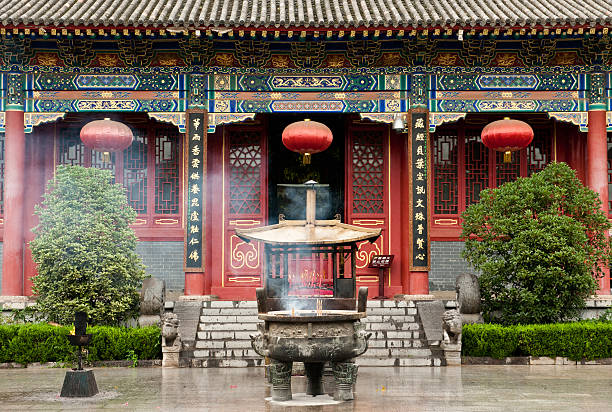
Famen Temple.
Main Highlights: What You Absolutely Can’t Miss
The Majestic Pagoda
Standing at an impressive 47 meters, the brick pagoda of Famen Temple is an architectural marvel that reflects the style of the early Tang Dynasty. This towering structure not only serves as a symbol of the temple but also houses the sacred relics of Sakyamuni Buddha. As you approach, take a moment to absorb the serene atmosphere and the stunning craftsmanship that surrounds you. Tip: Capture the pagoda from various angles for stunning photography, especially during sunrise or sunset when the light bathes it in a golden hue.
The Underground Palace
Beneath the pagoda lies the renowned Underground Palace, a treasure trove of Tang Dynasty relics discovered during archaeological excavations. Here, you can marvel at over 900 exquisite artifacts, including gold and silver wares, silk, and the revered finger bone relic of the Buddha. The meticulous craftsmanship of these treasures showcases the rich cultural heritage of Buddhism in China. Tip: Consider joining a guided tour to gain deeper insights into the history and significance of these relics.
Namaste Dagoba
A striking modern architectural piece, the Namaste Dagoba was completed in 2009 and stands at 148 meters tall, resembling two hands pressed together in prayer. This beautiful structure houses the precious relic of the Buddha’s finger bone, making it a pivotal spot for both spiritual seekers and architecture enthusiasts. Tip: Spend some time contemplating in front of the Dagoba; its peaceful surroundings are perfect for reflection and meditation.
Mahavira Hall
The glistening Mahavira Hall is a centerpiece of the temple, showcasing the exquisite craftsmanship of traditional Chinese architecture. Inside, you’ll find beautifully adorned Buddha statues that radiate tranquility. The hall is meticulously reconstructed to echo the grandeur of ancient times. Tip: Observe the intricate details of the hall’s design, and take a moment to sit quietly to fully appreciate the spiritual ambiance.
Famen Temple Museum
Adjacent to the temple, the Famen Temple Museum houses a remarkable collection of artifacts unearthed from the Underground Palace. This museum provides an in-depth look at the history of Famen Temple and its significance in the Buddhist world. Tip: Make sure to allocate some time to explore the museum; the entrance fee is included with your temple ticket, making it a cost-effective way to enrich your visit.
Foguang Avenue
As you exit the temple complex, stroll along Foguang Avenue, a beautifully landscaped pathway lined with colossal granite-carved Buddha statues. This 1230-meter stretch leads you from the temple gate to the pagoda square, enhancing the spiritual atmosphere of your visit. Tip: Take your time walking along the avenue to fully appreciate the intricate details of the statues; it’s also a great spot for photos that capture the essence of your pilgrimage.
The Treasure Pavilion
The Treasure Pavilion is the main building of the Famen Temple Museum, showcasing the most precious artifacts discovered during excavations. Its unique architectural design and elegant interior make it a highlight of your visit. Here, you can find rare treasures such as the gold-wire cassock of Empress Wu Zetian. Tip: Don’t rush through; allow yourself to linger and absorb the stories behind these extraordinary pieces, which are significant not just to Chinese history but to Buddhist culture worldwide.
Visiting Famen Temple is an enriching experience that intertwines spirituality, history, and artistry. Each highlight offers a unique insight into the temple’s significance, making it a must-see for any traveler exploring the depths of Chinese culture.
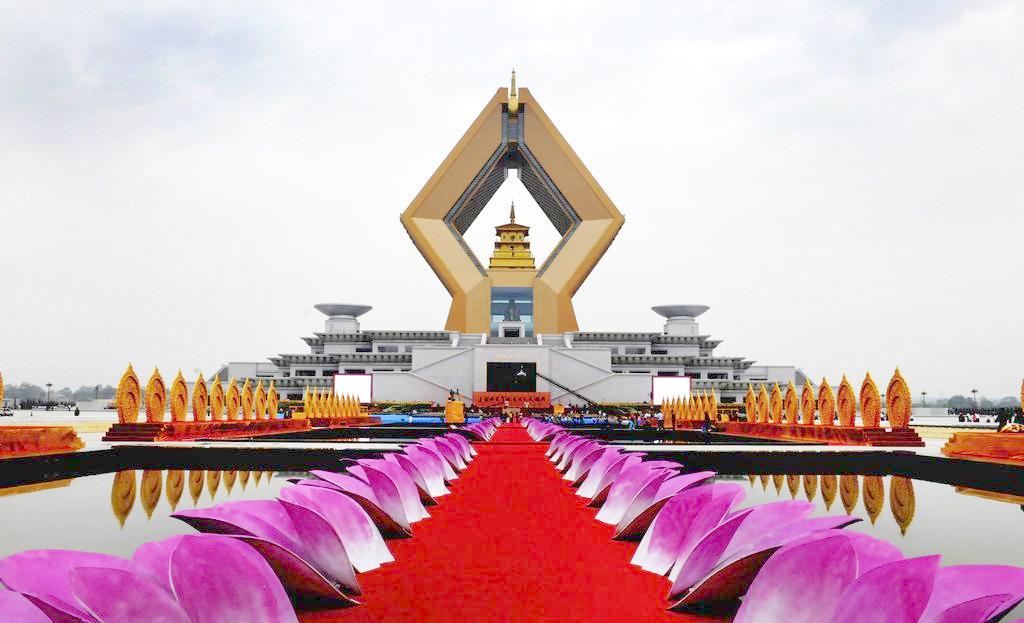
Famen Temple.
Planning Your Visit: A Practical Guide
Best Time to Visit
Famen Temple is a year-round destination, but the best times to visit are during spring (March to May) and autumn (September to November). During these seasons, the weather is mild and comfortable, making it ideal for exploring the temple grounds and the surrounding area. Summer can be hot and humid, while winter temperatures can drop, so plan accordingly based on your comfort preferences.
Recommended Itinerary
Half-Day Visit:
- 8:30 AM: Arrive at Famen Temple and purchase your entrance ticket (CNY 100).
- 8:45 AM: Start your exploration with the impressive main pagoda, taking time to admire the intricate architecture.
- 9:30 AM: Visit the Mahavira Hall and the Brass Buddha Hall, where you can appreciate the exquisite craftsmanship.
- 10:30 AM: Head to the Famen Temple Museum to view relics from the Underground Palace, including the revered sariras of Sakyamuni Buddha.
- 11:30 AM: Stroll through the temple grounds, enjoying the serenity and beautiful landscaping.
- 12:00 PM: Conclude your visit with a leisurely lunch at one of the nearby restaurants or cafes.
Full-Day Visit:
If you have more time, consider incorporating a visit to nearby attractions like the Zhouyuan Museum or the Jingwei Wetland Nature Reserve.
Photography Tips
- Respect the Site: Be mindful of your surroundings and avoid taking photos of the Buddha statues or monks without permission.
- Optimal Lighting: Early morning or late afternoon provides the best natural lighting for photography. The soft, golden light enhances the beauty of the temple’s architecture and landscapes.
- Use a Tripod: If you’re interested in capturing long-exposure shots of the pagoda, bringing a tripod can help stabilize your camera for clearer images.
- Capture Details: Don’t forget to focus on the intricate details of the temple’s architecture, including carvings and decorative features that showcase its rich history.
What to Wear
When visiting Famen Temple, it’s essential to dress modestly to show respect for the sacred site. Here are some recommendations:
- Comfortable Shoes: Wear comfortable walking shoes as you’ll likely be exploring the temple grounds for a few hours.
- Layered Clothing: Depending on the season, layers can help you adjust to the temperature throughout the day. Avoid shorts or sleeveless tops; opt for long pants and shirts with sleeves.
- Light Fabrics: In warmer months, choose breathable materials to stay cool while adhering to the dress code.
Insider Tips
-
Combine Visits: Consider combining your trip to Famen Temple with a visit to the nearby Hanyangling Museum to enrich your cultural experience. Many tour operators offer packages that include both sites.
-
Early Arrival: Arriving early not only helps you avoid larger crowds but also allows you to experience the temple in a peaceful atmosphere, perfect for contemplation and reflection.
-
Local Cuisine: Don’t miss the opportunity to try local Shaanxi dishes at nearby eateries. The region is famous for its hand-pulled noodles and biangbiang noodles.
-
Guided Tours: If you’re interested in a deeper understanding of the temple’s history and significance, consider joining a guided tour. Knowledgeable guides can provide insights you might otherwise miss.
-
Respectful Interaction: When you encounter monks or devotees, greet them politely. A simple nod or smile goes a long way in showing respect for the spiritual atmosphere of the temple.
By following this guide, you can ensure a fulfilling and respectful visit to Famen Temple, immersing yourself in its rich history and spiritual ambiance.
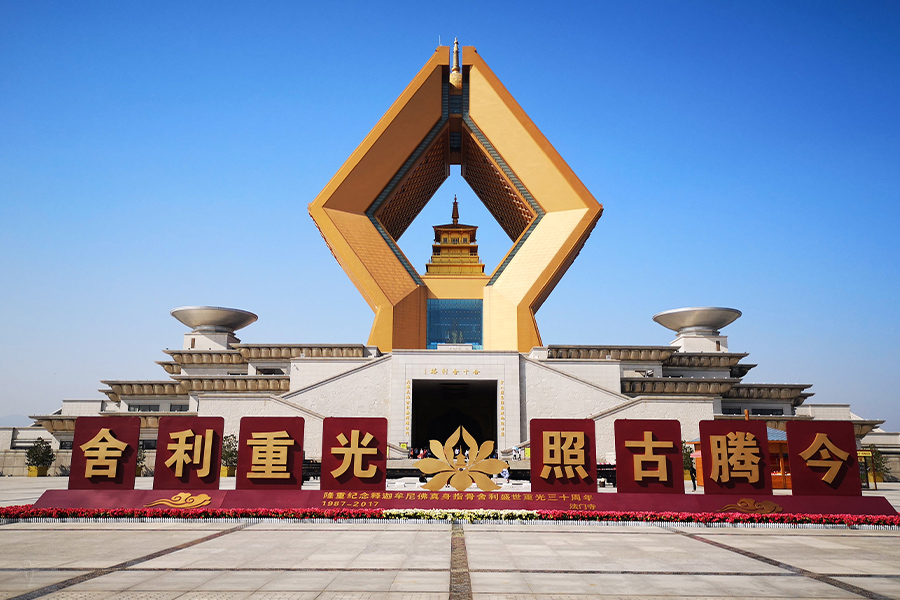
Famen Temple.
Tickets: Prices, Booking, and Tips
Visiting Famen Temple is a remarkable experience that immerses you in the rich history and spirituality of Buddhism. To ensure your visit goes smoothly, here’s everything you need to know about ticket prices, what’s included, and how to secure your entry.
| Ticket Type | Price (CNY) | Includes |
|---|---|---|
| Adult (March – November) | 100 | Entrance to Famen Temple and Famen Temple Museum |
| Adult (December – February) | 90 | Entrance to Famen Temple and Famen Temple Museum |
| Children (under 1.2m) | Free | Entrance to Famen Temple and Famen Temple Museum |
| Students (with ID) | 50 | Entrance to Famen Temple and Famen Temple Museum |
Booking Information
Tickets for Famen Temple can be purchased at the entrance, but it’s advisable to book in advance, especially during peak travel seasons, to avoid long queues and ensure availability. You can book tickets through various travel agencies or online platforms that specialize in tours of Xi’an and its surrounding attractions.
Tips for Booking:
- Advance Booking: Consider booking your tickets at least a few days ahead of your visit, particularly from March to November when the temple sees a surge in visitors.
- Combined Tours: Look for packages that include Famen Temple along with other attractions in the area, such as the Hanyangling Museum, which can enhance your experience.
- Group Discounts: If you are traveling in a group, inquire about group discounts, which can make your visit more economical.
Additional Tips
- Arrive Early: The temple opens at 8:30 AM, so arriving early will give you a head start on exploring the site before it gets crowded.
- Dress Modestly: As a place of worship, it’s important to dress respectfully. Opt for clothing that covers your shoulders and knees.
- Respectful Behavior: Maintain a quiet demeanor and follow the temple’s guidelines, especially when interacting with monks or taking photographs.
With these details in hand, you’re well-prepared to enjoy a meaningful visit to Famen Temple!
How to Get There: A Complete Transportation Guide
From the Nearest Major City
Traveling from Xi’an to Famen Temple
Famen Temple is located approximately 120 kilometers from Xi’an, making it accessible via several transportation options:
1. Tourist Bus:
– Departure Point: Big Wild Goose Pagoda (West Gate or North Square)
– Duration: About 2 hours
– Cost: Approximately CNY 30-50 (around $5-8)
– Frequency: Buses typically run several times a day, but it’s advisable to check the schedule in advance.
2. High-Speed Train:
– Departure Point: Xi’an North Railway Station
– Destination: Yangling South Railway Station
– Duration: Approximately 30 minutes
– Cost: Around CNY 50-80 (about $8-12)
– Transfer: Upon arriving at Yangling South, take a taxi to Famen Temple, which will take about 35 minutes and cost roughly CNY 80-100 ($12-15).
3. Long-Distance Bus:
– Departure Point: Xi’an West Coach Station
– Duration: Approximately 2 hours
– Cost: About CNY 50-70 (around $8-11)
– Notes: This option offers direct service to Famen Temple, making it a convenient choice.
4. Private Car Hire:
– Option: Renting a car with a driver from a local travel company
– Duration: About 1.5 to 2 hours depending on traffic
– Cost: Prices vary but expect around CNY 500-800 ($75-$120) for a round trip.
– Benefits: This is the most convenient and comfortable option, allowing for a flexible itinerary.
Getting Around the Scenic Area
Once you arrive at Famen Temple, navigating the area is straightforward:
On Foot
- Temple Grounds: The complex is pedestrian-friendly, and walking is the best way to fully appreciate its stunning architecture and serene atmosphere. Expect to spend about 2-4 hours exploring the temple and its surroundings.
Local Transportation
- Taxis and Ride-Sharing: Taxis are available near the entrance of Famen Temple for local trips. Ride-sharing services like Didi can also be used for a more convenient experience.
- Bicycles: Some visitors choose to rent bicycles from nearby shops to explore the surrounding areas at a leisurely pace.
Additional Tips
- Entrance Fee: The entrance fee to Famen Temple is CNY 100 per person from March to November and CNY 90 from December to February. This fee includes access to the adjacent Famen Temple Museum, where you can view numerous historical relics.
- Dress Code: Remember to dress modestly to show respect for the sacred site. Avoid clothing that exposes too much skin.
- Photography: Always ask for permission before photographing statues or monks, as certain areas may have restrictions.
With these options, traveling to Famen Temple from Xi’an is convenient and allows you to experience one of China’s most significant Buddhist sites. Prepare for a fulfilling journey into history and spirituality.
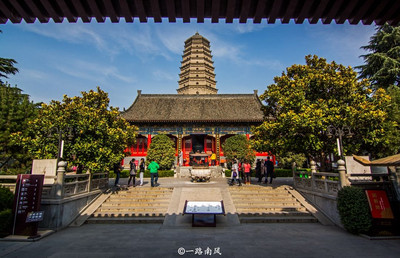
Famen Temple.
Local Cuisine and Accommodation Nearby
When visiting Famen Temple, not only can you immerse yourself in its rich history and stunning architecture, but you’ll also have the chance to savor the local flavors and find comfortable accommodations nearby. Here are some recommendations to enhance your travel experience.
Local Cuisine
1. Guokui (锅盔)
This traditional flatbread, often filled with savory delights, is a must-try when in Shaanxi Province. Guokui is usually baked to a golden crisp, giving it a satisfying crunch. Many vendors near the temple offer versions stuffed with spiced meats, vegetables, or even sweet fillings, making it a perfect snack to enjoy while exploring.
2. Yangrou Paomo (羊肉泡馍)
A hearty and comforting dish, Yangrou Paomo features shredded flatbread soaked in rich lamb broth, often accompanied by tender lamb pieces. This dish is particularly popular among locals and is perfect for a filling lunch after a morning of sightseeing.
3. Liangpi (凉皮)
Ideal for warmer days, Liangpi is a cold noodle dish made from wheat or rice flour, served with a tangy and spicy sauce. Topped with fresh vegetables and often meat, it’s refreshing and packed with flavor. Look for stalls or small restaurants where you can enjoy this popular street food.
4. Roujiamo (肉夹馍)
Often referred to as “Chinese hamburger,” Roujiamo consists of minced meat, typically pork or beef, served inside a soft, warm flatbread. This handheld delight is a satisfying option for those on the go, and you can find various regional interpretations, each with its unique twist.
Accommodation Options
Luxury: Famen Temple Hotel
For a truly immersive experience, consider staying at the Famen Temple Hotel. This upscale hotel offers elegant accommodations and stunning views of the temple and surrounding mountains. With fine dining options and wellness facilities, it’s perfect for travelers seeking comfort and tranquility.
Boutique: Baoji Famen Temple Culture Hotel
This boutique hotel combines modern design with traditional elements, offering a unique stay just a stone’s throw from the temple. Each room is tastefully decorated, reflecting the local culture. The hotel also features a cozy café, perfect for enjoying local snacks and tea during your stay.
Budget: Famen Temple Youth Hostel
If you’re looking for affordable yet comfortable lodging, the Famen Temple Youth Hostel is a great choice. This budget-friendly option offers dormitory-style and private rooms, making it an excellent choice for backpackers and budget travelers. The friendly staff can also assist you with local tips and tours.
Conclusion
With an array of delectable local dishes to try and a range of accommodations to suit every preference, your visit to Famen Temple will be both enriching and comfortable. Whether you’re savoring the flavors of Shaanxi or relaxing in a cozy hotel, you’re sure to create lasting memories.
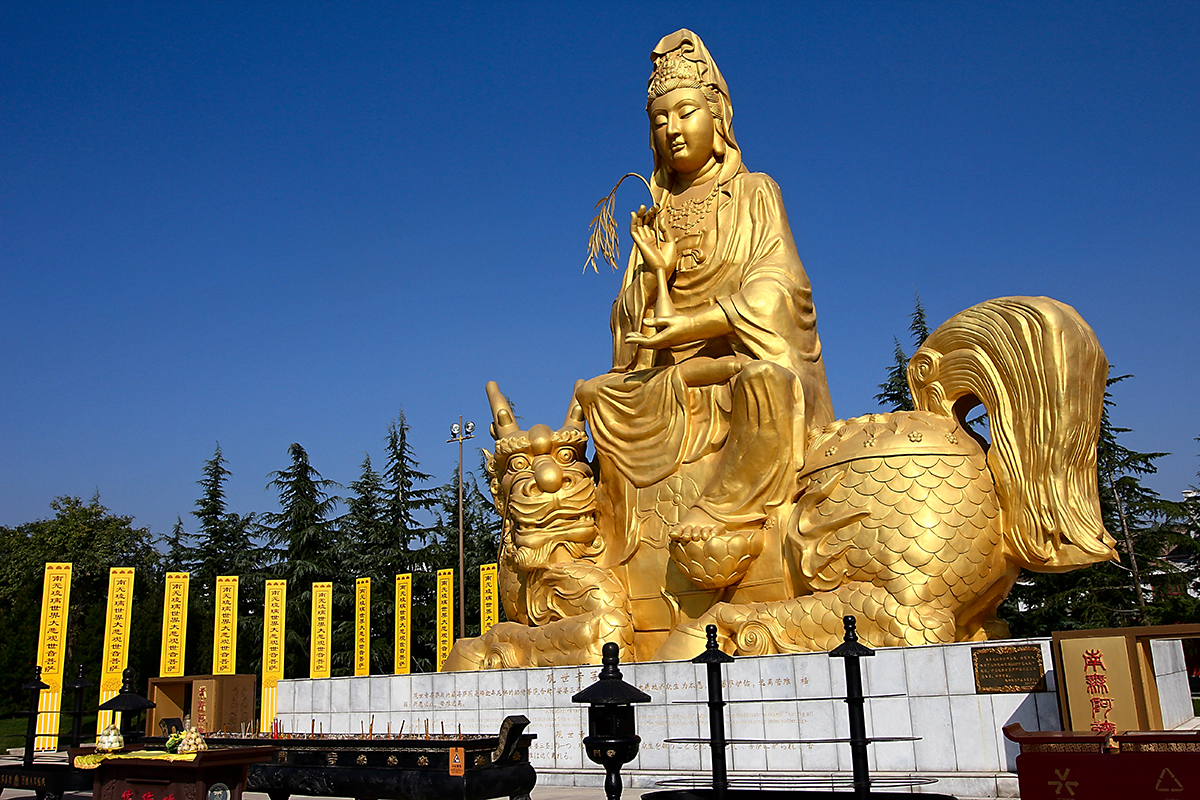
Famen Temple.
Frequently Asked Questions
Frequently Asked Questions about Famen Temple
1. Is Famen Temple suitable for children and the elderly?
Yes, Famen Temple is suitable for both children and the elderly. The temple features wide paths and accessible areas, making it easy for families with young children and seniors to navigate. However, as it is a religious site, parents should supervise children and encourage them to maintain a respectful demeanor.
2. Are English signs available at Famen Temple?
Yes, you will find English signage throughout Famen Temple, including informational displays and directions. This makes it easier for international visitors to understand the rich history and significance of the temple’s various features.
3. How much time should I plan for my visit?
Plan to spend approximately 2 to 4 hours at Famen Temple. This allows ample time to explore the temple grounds, visit the museum housing the cultural relics, and take in the intricate architecture. If you are particularly interested in photography or detailed exploration, consider allocating more time.
4. What are the opening hours of Famen Temple?
Famen Temple is open daily from 8:30 AM to 5:30 PM. It’s advisable to arrive early to avoid crowds, especially on weekends and holidays.
5. Is there an entrance fee?
Yes, the entrance fee for Famen Temple is CNY 100 per person from March to November and CNY 90 per person from December to February. This fee includes access to the temple and the adjoining museum.
6. What should I wear when visiting Famen Temple?
Visitors are encouraged to dress modestly to show respect for the religious site. It is best to avoid clothing that is too revealing. Comfortable shoes are also recommended, as there will be some walking involved.
7. Are there any dining or shopping options near Famen Temple?
Yes, there are various restaurants and shops located around the temple area. Visitors can enjoy local cuisine or purchase souvenirs and snacks before or after their visit.
8. How can I get to Famen Temple from Xi’an?
There are several options for reaching Famen Temple from Xi’an:
– Tourist Bus: Depart from the Big Wild Goose Pagoda, taking about 2 hours.
– High-Speed Train: Take a train from Xi’an North Railway Station to Yangling South Railway Station, followed by a taxi ride of about 35 minutes.
– Long-Distance Bus: Direct buses from Xi’an West Coach Station also take around 2 hours.
– Car Rental: Renting a car with a driver is another convenient option.
Final Thoughts on Your Trip
Visiting Famen Temple is more than just a journey through ancient architecture; it’s an immersive experience into the heart of Buddhist history and spirituality. With its stunning pagoda, revered relics, and the serene ambiance of the temple grounds, you are invited to reflect on the profound legacy of Sakyamuni Buddha and the rich tapestry of culture that surrounds this sacred site.
As you wander through the beautifully restored halls and gaze upon invaluable artifacts from the Tang Dynasty, take a moment to appreciate the convergence of faith, art, and history that this temple embodies. Whether you’re a devoted practitioner, a history enthusiast, or simply a curious traveler, Famen Temple offers a unique glimpse into a world where the past and present coexist in harmony.
As you prepare to leave this sacred space, carry with you the tranquility and inspiration drawn from its serene atmosphere. Allow your visit to Famen Temple to be a reminder of the enduring power of faith and the beauty of cultural heritage. Embrace the journey, and let it enrich your understanding of the world and its diverse spiritual landscapes. Safe travels!